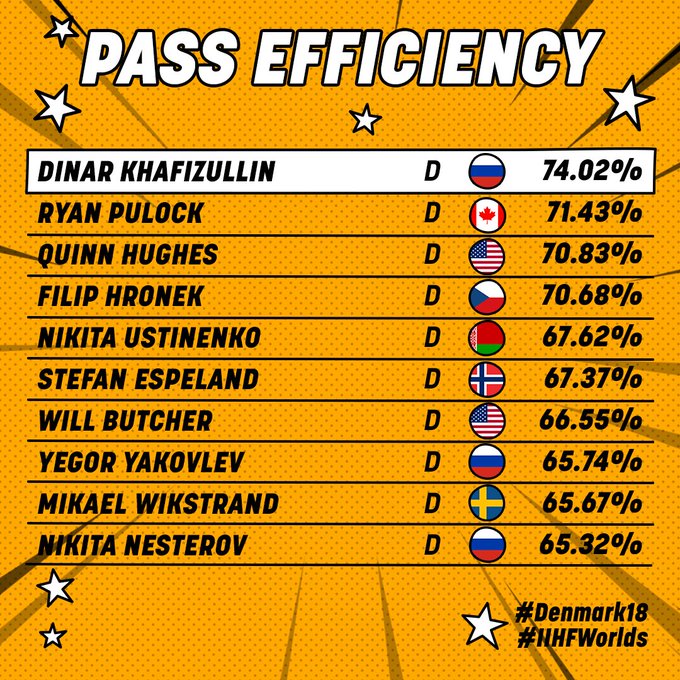Who's the best passer? While Johnny Gaudreau had the most completed passes, Russian defenceman Dinar Khafizullin of @russiahockey_en and @hcSKA_News had the best passing success rate at the #IIHFWorlds!
Nation Sites
The Nation Network
CanucksArmy has no direct affiliation to the Vancouver Canucks, Canucks Sports & Entertainment, NHL, or NHLPA
CANUCKSARMY’S 2018 NHL DRAFT RANKINGS: #4 Quinn Hughes
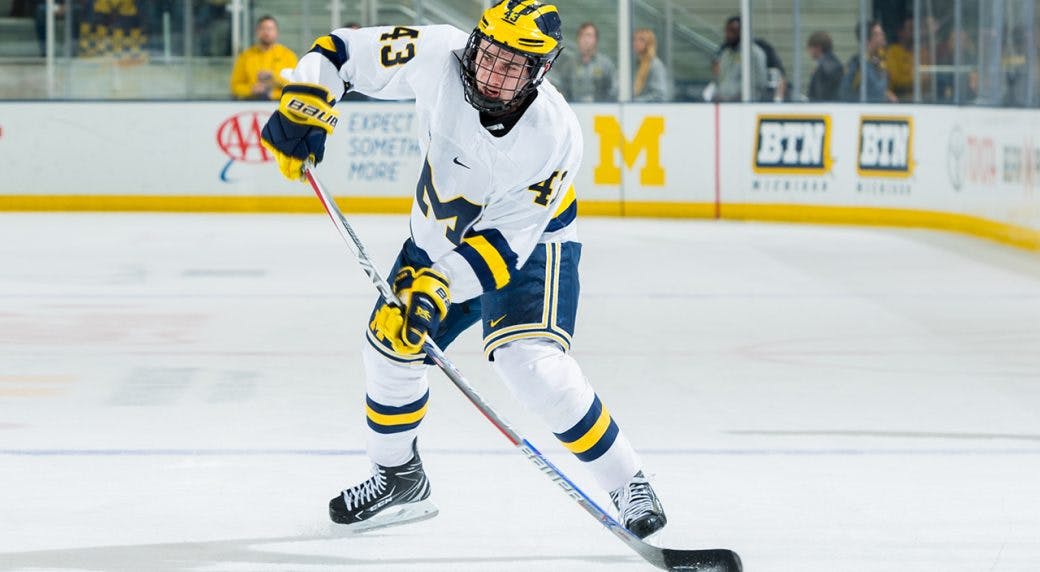
Photo credit: University of Michigan
Jun 15, 2018, 14:00 EDTUpdated: Jun 15, 2018, 16:28 EDT
Let me be clear: there is nothing I am more sick and tired of hearing about than a player’s height. It’s exhausting, it’s boring, and in most cases, it’s largely irrelevant. Thirty defencemen scored 40 points or more in the NHL last season. 9 were less than six feet tall. Three were less than 5’10”. Forty-five defenders 5’11” or under played an NHL game this season. You can count some of them, like Shayne Gostisbehere, Tyson Barrie, Ryan Ellis, and Jared Spurgeon, as among the best in the game.
And yet every year, the scouting community is inundated with “smurf” comments from a dedicated group of the dumbest people online. Every year, players with no serious deficiencies in their game are still assumed to be inferior because of what often amounts to a difference of less than an inch.
In most cases, height amounts to little more than an aesthetic preference. But hockey is a skills competition, not a beauty contest. It’s less meaningful as a physical input than wingspan, centre of gravity, stride, VO2 max and a whole host of other things that are rarely mentioned. If you can’t actually point out an area of the game where a player’s small stature is costing him, then it doesn’t matter.
Quinn Hughes isn’t a big player, but if you saw him on the street, you wouldn’t look twice at him. Most outlets have him listed at 5’10” – literally the average height for a North American male. I can’t believe this is even a talking point.
Big, hulking, crease-clearing defenders are going the way of the dinosaur for one simple reason: if a defenceman has to clear the crease, he’s already failed to do 95% of his job. That 95%- skating, rushing, passing, transitioning, breaking up plays, etc. – is where Quinn Hughes excels.
If Muggsy Bogues can have a 14-year career in the NBA, you bet Quinn Hughes can be an NHLer. And a damn good one, too. In every meaningful area of the game, he stands apart from every defenceman in this year’s draft not named Rasmus Dahlin. He clocks in at #4 on our yearly rankings.
Bio
- Age/Birthdate: 17.92/ October 14, 1999
- Birthplace: Orlando, FL, USA
- Frame: 5’10” / 174 lbs
- Position: D
- Handedness: L
- Draft Year Team: University of Michigan (NCAA)
- Accomplishments/Awards:
Stats
Career
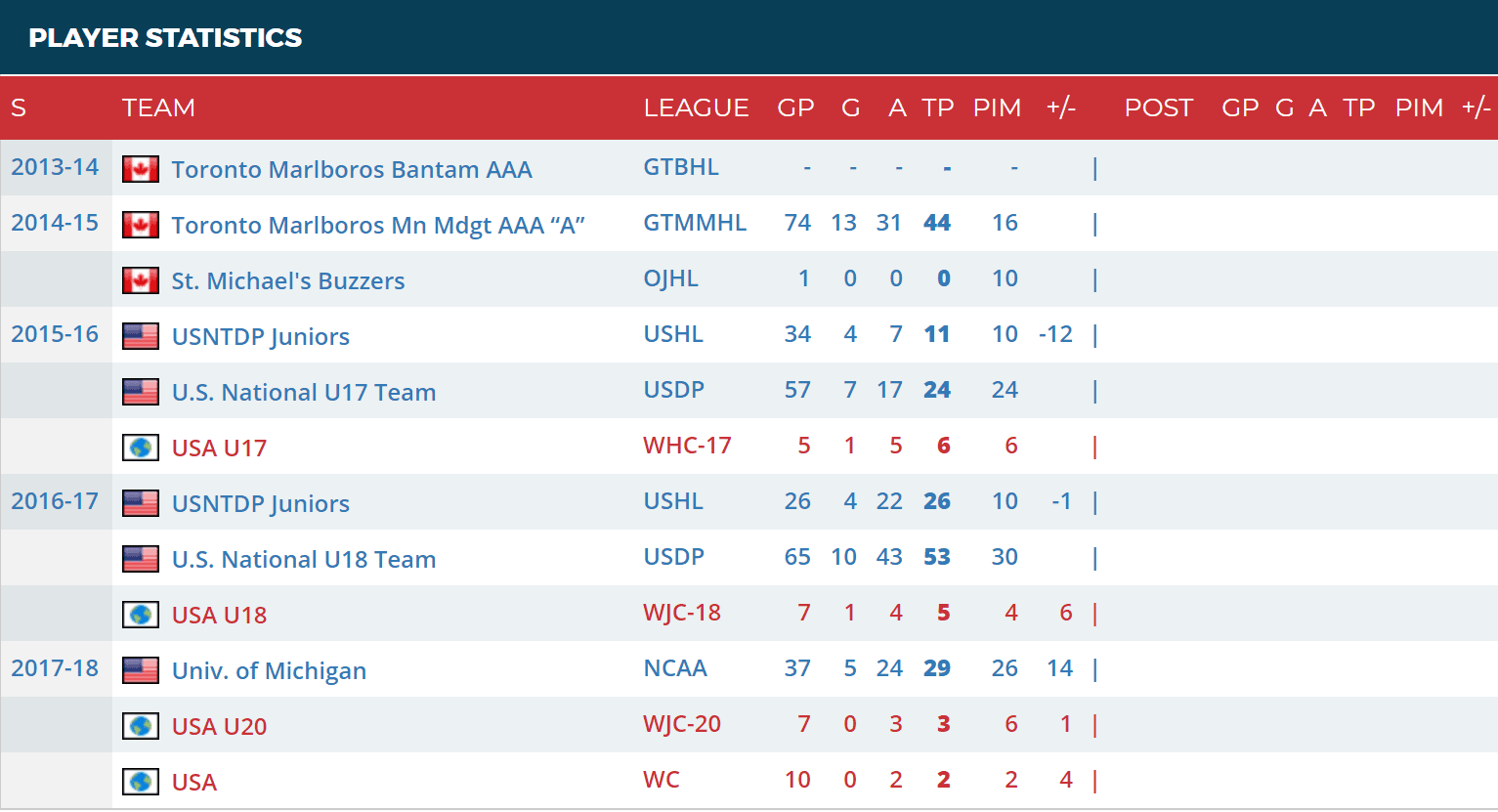
2017-18 Season
GP | G | A | P | SEAL | INV% | 5v5 Pr INV% | 5v5 eP160 | Sh/Gp | Sh% | GF% | GF%rel | GD60rel | XLS% | XPR | xVAL |
37 | 5 | 24 | 29 | 1.22 | 23.2% | 14% | 1.09 | 2.51 | 5% | 61.4% | 7.4% | 0.9 | 33% | 31.8 | 3.4 |
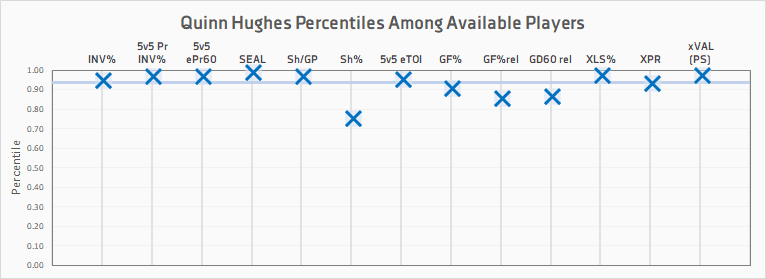
Adjusted Scoring (SEAL)
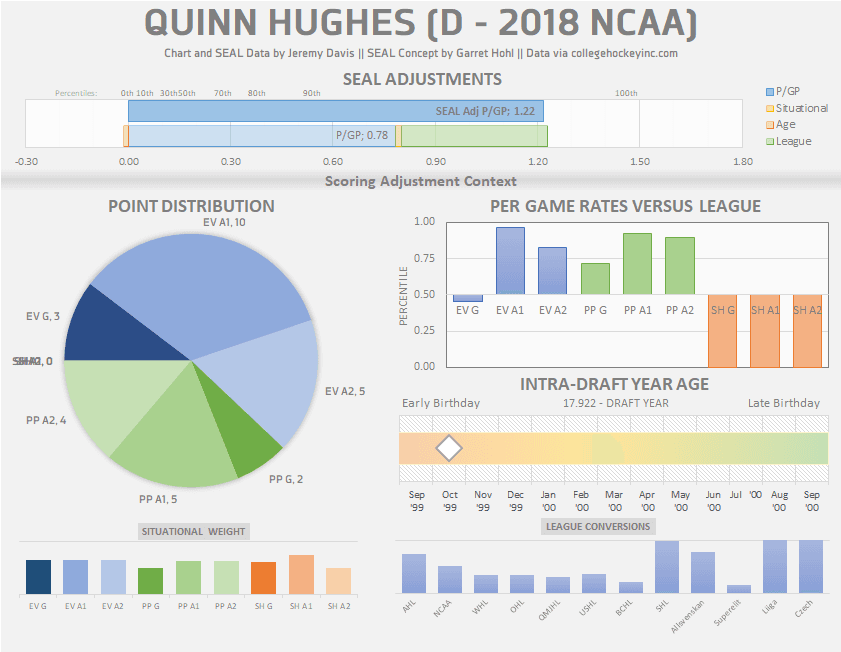
Team Relative
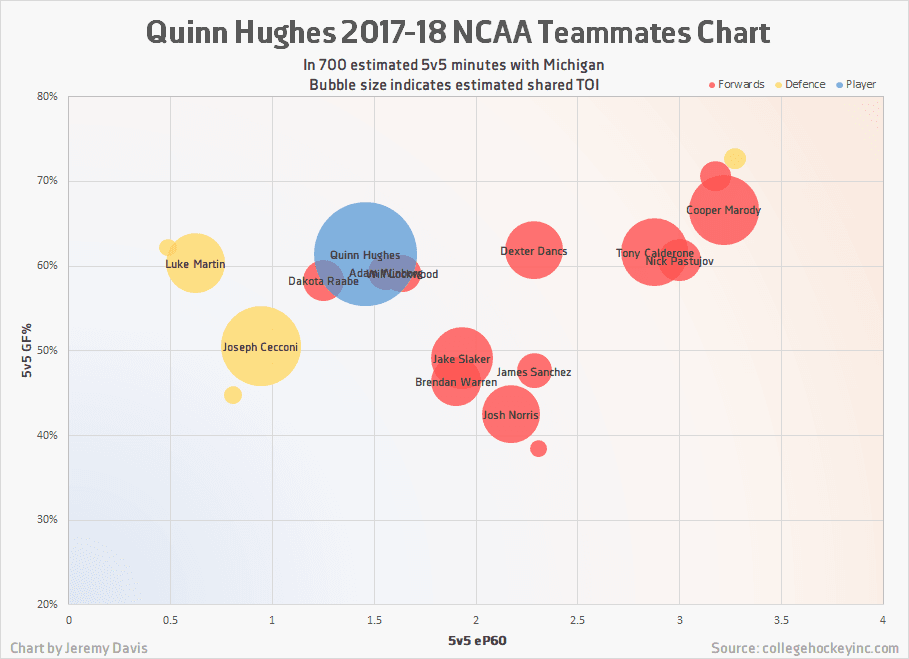
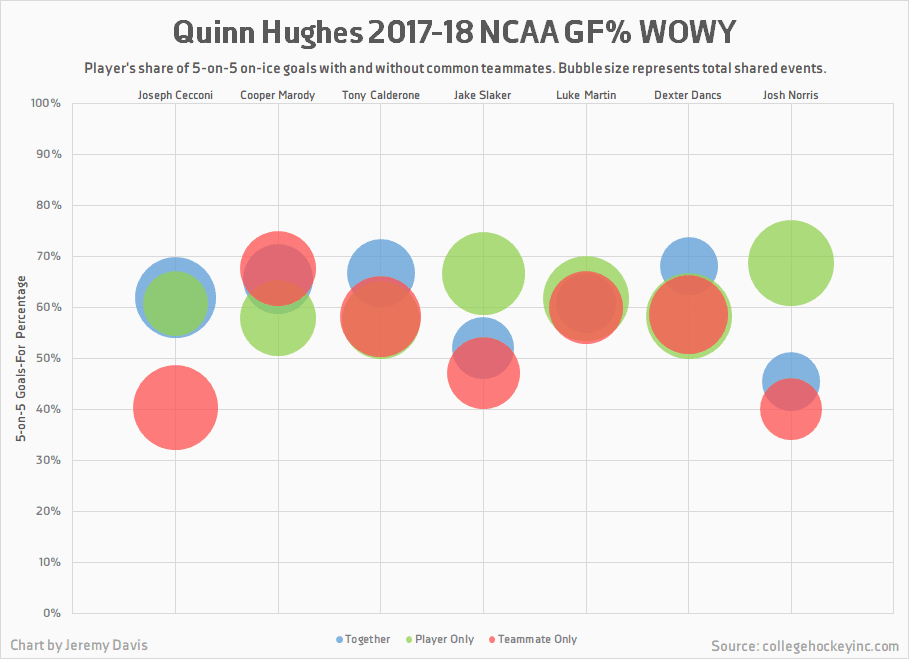
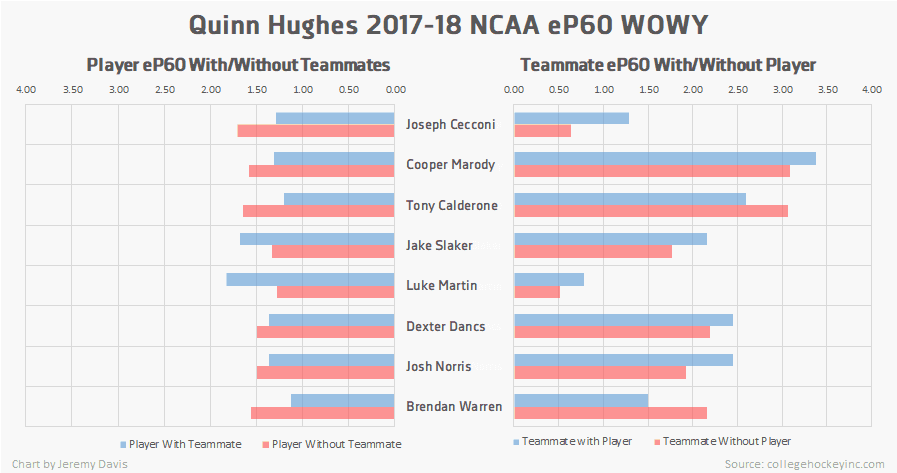
Cohort Based
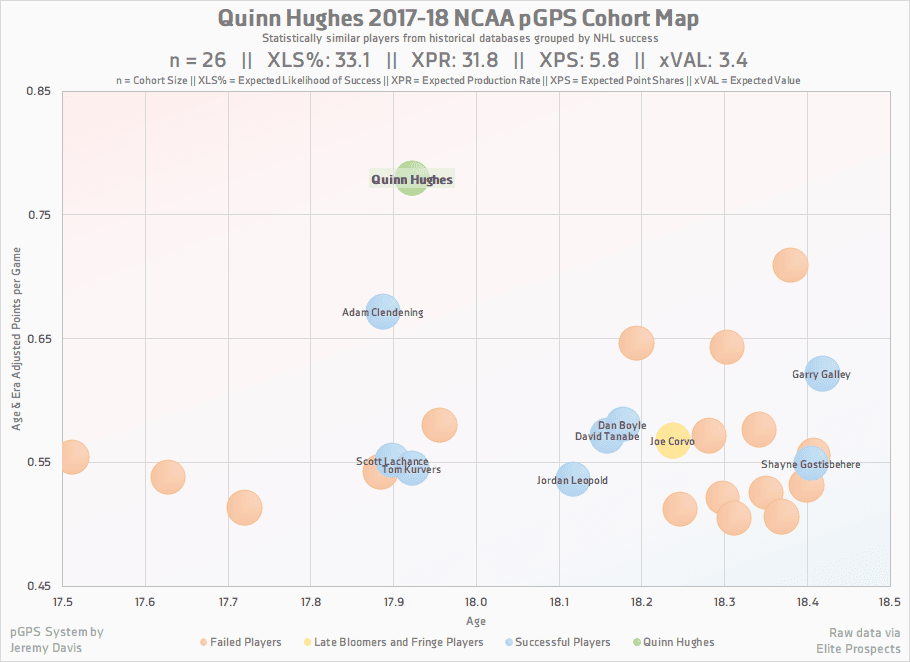
Our Take
I’ve been following Hughes for two years now and I feel comfortable saying that Quinn Hughes is one of the smoothest, most effortless skaters I’ve ever seen… at any level. When we talk about skating, there are a number of different elements we look at: top speed, acceleration, edgework, etc. Hughes has it all. Watching Hughes rush the puck up the ice is a sight to behold. He consistently uses his superior skating ability to create separation between him and his opponents. His edge control is so vastly superior to most of his peers that he is able to quickly turn or pivot and end up two or three strides ahead of a pressuring attacker.
Offensively, Hughes has a high-end and diverse set of skills. He’s creative and dynamic with the puck, pulling off moves even most forwards couldn’t dream up, let alone execute. His two-step quickness and deceptiveness allow him to catch opponents flat-footed, and he has the hands to keep the puck moving as fast as his feet. His outlet passes are crisp and clean, which makes him a potent weapon on the breakout when paired with his ability to rush the puck on his own. His shot doesn’t have much pop, but he more than makes up for this by thinking the game two or three steps ahead of his peers. Unlike most defenders, Hughes prefers to shoot mostly when there’s a chance to score. Otherwise, he’d rather get the puck to a teammate in a high-danger area. In the attacking zone, Hughes doesn’t make the right play. He makes the better play.
Hughes’ confidence in his skating ability is a bit of a double-edged sword. In most instances, it makes him a threat to create offence out of nothing. The downside to this is that sometimes he can be too confident and skate the puck into an area he can’t safely get out of. As a result, he turns the puck over a lot. That’s something you accept from a player with his skill set, but if he could just tweak his decision-making by about 5-10% and learn when to make the safe play he’ll shed the “risky” label.
Some people might look at Hughes’ small stature and reputation as a dynamic offensive player and assume he has deficiencies on the defensive side of the game. They would be wrong. While his occasional turnovers make him riskier in the neutral zone than his peers and his small frame can result in struggles to win puck battles at times, Hughes’ defending is excellent. His speed makes him a tenacious and dedicated backchecker, and he has an active stick which he uses to break up passing plays. As you might expect, his speed and puck skills also mean that once he regains possession, the puck doesn’t stay in his own zone for long.
Interestingly, pGPS doesn’t shine as positive of a light on Hughes as it does some of the other defenders in the 2018 class. He carries an expected success percentage of just 33%. There are a few reasons for this. First, most of Hughes’ season was so good most of his matches barely meet the similarity threshold. Draft-year players are still a rarity in the NCAA, and many of his matches played there before it was the breeding ground for NHL talent it is today. It’s also important to consider that Hughes’ numbers at the college level were better than all his matches, and his height does him a bit of a disservice, too. In this case, we have to look outside the confines of the model. Hughes had a better freshman season than Zach Werenski did in his draft year, and he’s turned out to be one of the league’s best young defenders.
When looking at Hughes’ situation, era, age, and league (SEAL) adjusted scoring, we get a better impression of how strong a season he had. Of this year’s crop of defencemen, only Rasmus Dahlin and Evan Bouchard had a higher SEAL-adjusted scoring rate.
Any concerns about Hughes’ ability to translate to the pro game should be assuaged by his stand out play against some of the best players in professional hockey, where Hughes ranked third overall in pass efficiency.
When looking at the body of work, Hughes has separated himself from the pack. Outside of the obvious choice at first overall, Hughes is the defenceman with the best chance at being a truly special talent. If there’s any justice in this world, he’ll be the first player at that position to hear his name called after Rasmus Dahlin on draft day.
Further Reading
Consolidated | Average | Future Considerations | Hockey Prospect.com | ISS Hockey | McKeen’s | The Athletic | TSN Bob McKenzie | TSN Craig Button | The Hockey News | Sportsnet | ESPN | Dobber Prospects |
6 | 6.2 | 6 | 7 | 7 | 4 | $$ | 6 | 12 | 6 | 9 | 5 | 3 |
From Cam Robinson, Dobber Prospects:
A consummate playmaker who boasts the elite speed needed to thrive at his stature. The youngest player in the NCAA this season, his confidence continued to build all season long. He was tremendous for Michigan down the stretch and looked more than capable at the World Championships. The best skater in this class and a one-man breakout machine. He can run a power play with the best of them. Needs some more pop on his shot.
ARTICLE BROUGHT TO YOU BY SPORTS EXCELLENCE

Founded in 1950, Sports Excellence Corporation represents over 150 family-owned independent hockey retailers across Canada and the United States. Our highly knowledgeable hockey specialists are available to assist all your equipment needs. Find your closest Sports Excellence retailer here!
CanucksArmy’s 2018 NHL Draft Rankings
#6 Jesperi Kotkaniemi | ||
Breaking News
- Was this the absolute best time for the Canucks to trade Quinn Hughes?
- The Farmies: Jonathan Lekkerimäki walks it off as Abbotsford Canucks defeat Wranglers 3-2 in overtime
- Canucks Game Day: Dawn of a new era in early Sunday start against the Devils
- Bieksa offers thoughts on Hughes’ Canucks legacy and raves about Zeev Buium
- The mystery box from the Hughes trade: What the Canucks have in Liam Öhgren

